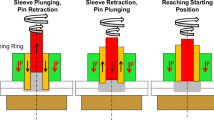Abstract
Starting with a brief presentation of the boundary conditions and the refill friction stir spot welding of high strength aluminum alloys, this paper introduces the quality criteria of refill friction stir spot welded joints. Afterwards, the paper discusses the influences of the process parameters on the joint formation and load-bearing capacities. Due to possible industrial application fields in automotive and airplane production, in which the combination with sealer or adhesives gets increasingly important, hybrid joining (combination of spot-shaped refill friction stir spot welds and sealer or adhesives) will also be discussed. Due to increased tool wear and contamination, different strategies for driving the polymer out of the joint area will be shown and compared. As the assurance of the joint quality with the help of nondestructive testing (NDT) plays an important role, an ultrasonic-based testing procedure will be shown. Additionally, a repair concept by “over-welding” will be investigated by destructive and nondestructive (ultrasonic testing procedure) testing for selected failure modes. The paper closes with specific recommendations for the realization of elementary and hybrid refill friction stir spot welded joints which meet the quality demands, and an outlook for further research steps will be given.











Similar content being viewed by others
References
Regulation (EC) NO 443/2009 of the European parliament and of the council (2009) Setting emission performance standards for new passenger cars as part of the Community’s integrated approach to reduce CO2 emissions from light-duty vehicles. Off J Eur Union. https://www.eea.europa.eu/policy-documents/443-2009
FRIEDRICH H, TREFFINGER P, KOPP G, KNÄBEL H (2008) Werkstoffe und Bauweisen ermöglichen neue Fahrzeugkonzepte (Materials and construction methods enable new vehicle concepts). Chapter in Book: Schindler, V.; Sievers, I.: Forschung für das Auto von Morgen. Springer Verlag, Berlin, pp. 301–347
EUROPEAN ALUMINIUM ASSOCIATION (2013) The Aluminium Automotive Manual. https://www.european-aluminium.eu/resource-hub/aluminium-automotive-manual. Accessed 28 Mai 2018
ZHANG CQ, ROBSON JD, Prangnell PB (2016) Dissimilar ultrasonic spot welding of aerospace aluminum alloy AA2139 to titanium alloy TiAl6V4. J Mater Process Technol 231:382–388
ZHANG N, WANG W, CAO X, WU J (2015) The effect of annealing on the interface microstructure and mechanical characteristics of AZ31B/AA6061 composite plates fabricated by explosive welding. Mater Des 65:1100–1109
JAFARIAN M et al (2016) Effect of thermal tempering on microstructure and mechanical properties of Mg-AZ31/Al-6061 diffusion bonding. Mater Sci Eng A 666:372–379
ZECH F, CRAMER H, APPEL L (2010) Reibpunktschweißen von Überlappverbindungen an Aluminiumknet- und –gusslegierungen im Vergleich; Final report of AiF-IGF-Project 15.317N. GSI SLV München, funded by the Ministry of Economics and Technology. Munich
CHU Q, LI WY, YANG XW, SHEN JJ, LI YB, WANG WB (2017) Study of process/structure/property relationships in probeless friction stir spot welded AA2198 Al-Li alloy. Welding in the world 61:291–298
DIN EN ISO 14273 (2016): Widerstandsschweißen. Zerstörende Prüfung von Schweißverbindungen. Probenmaße und Verfahren für die Scherzugprüfung an Widerstandspunkt-, Rollennaht- und Buckel-schweißungen mit geprägten Buckeln. Beuth Verlag GmbH
DIN EN ISO 14272 (2016) Widerstandsschweißen. Zerstörende Prüfung von Schweißverbindungen. Probenmaße und Verfahren für die Kopfzugprüfung an Widerstands- und Buckelschweißungen mit geprägten Buckeln. Beuth Verlag GmbH
Harms+Wende GmbH & Co. KG (2018) Technical data sheet “Reibpunktschweißen - das neue Verfahren”; RPS-System-Broschüre; https://www.harms-wende.de/fileadmin/hwh/HWH_brochures/30960-00-000-de_RPS100_Prospekt.pdf. (10.08.2018, 2:04pm)
Tier M, Dos Santos JF, Rosendo TDS, et.al (2009) A Study About the Mechanical Properties of Alclad AA2024 Connections Processed by Friction Spot Welding. Congresso Internacional da Associação Brasileira de Metalurgia – ABM, At Belo Horizonte - MG, Volume: 64
Amanico-Filho S, Camillo A, Bergmann L, Dos Santos JF et al (2011) Preliminary investigation of the microstructure and mechanical behaviour of 2024 Aluminium alloy friction spot welds. Mater Trans 52(5):985–991
SANTOS T, VILACA P, DOS SANTOS JF, QUINTINO L (2009) A new NDT system for micro imperfections detection: application to FSW and FSpW. Welding in the World, Vol 53, pp 361–366
Acknowledgments
The results are generated within the cooperation work with PFW Aerospace GmbH. Materials and Sealer were provided by PFW Aerospace GmbH.
Funding
In this paper, selected results of the funded research project 20W1506C were presented. This project is funded by the German Federal Ministry of Economic Affairs and Energy based on a decision of the German Bundestag and managed by the German Aerospace Center (DLR).
Author information
Authors and Affiliations
Corresponding author
Additional information
Recommended for publication by Commission III - Resistance Welding, Solid State Welding, and Allied Joining Process
Rights and permissions
About this article
Cite this article
SCHMAL, C., MESCHUT, G. & BUHL, N. Joining of high strength aluminum alloys by refill friction stir spot welding (III-1854-18). Weld World 63, 541–550 (2019). https://doi.org/10.1007/s40194-018-00690-0
Received:
Accepted:
Published:
Issue Date:
DOI: https://doi.org/10.1007/s40194-018-00690-0




